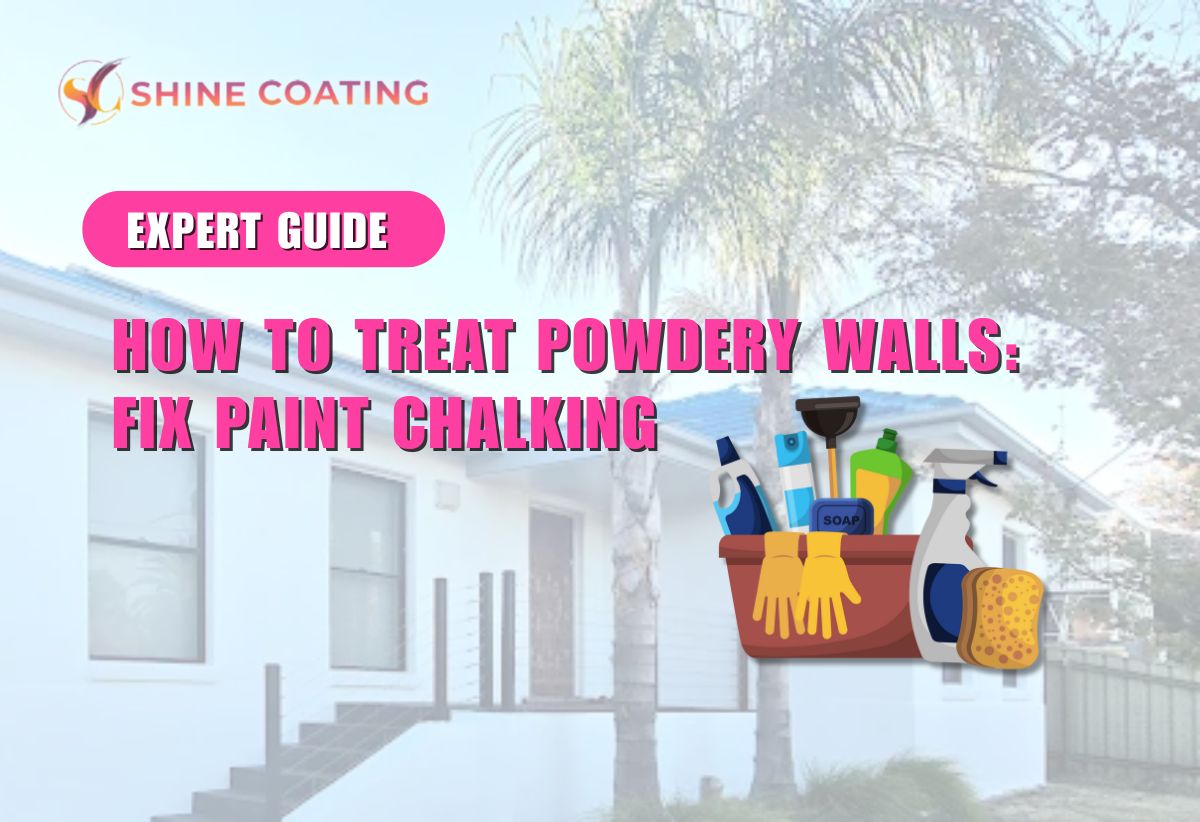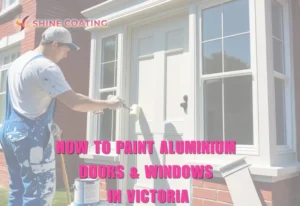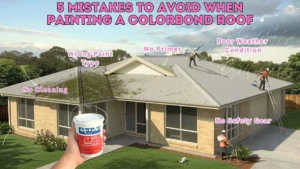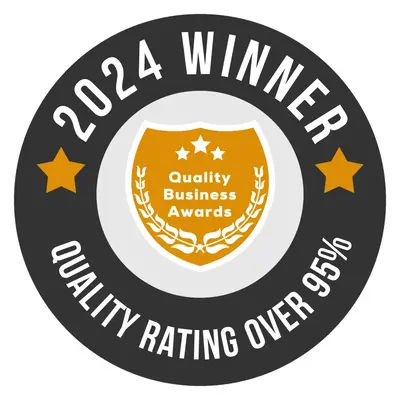Are your walls leaving a fine, white powder on your fingers when you touch them? You’re dealing with paint chalking – one of the most common paint defects affecting Australian homes.
As professional painters who’ve tackled countless chalking issues across Victoria, we’ll guide you through everything you need to know about identifying, treating, and preventing powdery walls.
Table of Contents
What Exactly is Paint Chalking?
Paint chalking occurs when your paint’s binder – the component that holds pigment particles together and bonds them to the surface – breaks down over time. This degradation leaves behind a fine, powdery residue that’s often white or a faded version of your original paint colour.
The telltale signs include:
- Fine powder that rubs off when you touch the wall
- Dull, faded appearance on painted surfaces
- White dusty residue on floors near affected walls
- Paint that easily wipes away with a cloth
Important: Don’t confuse this paint defect with decorative “chalk paint” – that’s an intentional finish. Paint chalking is an unwanted failure that compromises your paint’s protective qualities.
Why Australian Homes Are Particularly Vulnerable
Australia’s intense UV radiation makes our homes especially susceptible to paint chalking. Here’s why:
UV Radiation: Australia’s Harsh Sun
Our high solar radiation intensity means surfaces facing north experience significantly more UV exposure than in other climates. This constant bombardment breaks down paint binders faster, particularly on:
- North-facing exterior walls
- Properties in Queensland and Northern Australia
- Unshaded surfaces receiving direct sunlight
The Unique “Mega Thirsty” Plaster Problem
A distinctly Australian issue we encounter regularly involves unsealed plaster walls. New or old plaster that hasn’t been properly sealed will literally suck the moisture out of paint, leaving behind chalky residue. This is especially common in:
- Newly renovated Victorian-era homes
- Properties with fresh plaster work
- Older homes where proper sealing was skipped
Is Paint Chalking Dangerous? The Lead Paint Reality
Critical Safety Warning: If your home was built before 1978, chalking paint could be releasing toxic lead dust.
High-Risk Properties
- Homes built before 1978 (when lead paint was banned)
- Properties from the 1950s may contain up to 50% lead in paint
- Heritage homes and older Australian terraces
Who’s Most at Risk?
- Children under 6: Brain damage, developmental delays, learning difficulties
- Pregnant women: Risk to unborn babies
- Renovators: Exposure through disturbing lead paint
Safety Precautions
- Never dry sand or scrape potentially lead-contaminated paint
- Consult a certified lead professional before any work on pre-1978 homes
- Use wet cleaning methods to minimise dust
- Limit access to affected areas until professionally assessed
Step-by-Step Guide: How to Treat Powdery Walls
Once you’ve identified paint chalking and addressed any potential lead paint concerns, it’s time to restore your walls to their former glory.
The key to success lies in thorough preparation – rushing this process will only lead to recurring problems within months.
Step 1: Assess the Chalking Severity
Rub the affected surface with your finger or a dark cloth. The amount of powder that transfers indicates how extensive your treatment needs to be.
Step 2: Clean the Surface Thoroughly
For Interior Walls:
- Start with soap and warm water
- Use a damp cloth or soft brush for gentle cleaning
- For stubborn chalking, use sugar soap (available in wipes or concentrate)
For Exterior Surfaces:
- Pressure wash or use a stiff scrub brush
- Apply Resene Paint Prep and Housewash for weatherboards
- Scrub with a soft-bristled brush using detergent-based wash
Recommended Australian Cleaning Products:
| Product | Best For | Availability |
|---|---|---|
| Sugar soap wipes | Light interior chalking | Bunnings, paint stores |
| Sugar soap concentrate | Heavy interior grime | Hardware stores |
| Trisodium Phosphate (TSP) | Severe chalking | Specialty paint suppliers |
| Resene Paint Prep | Exterior weatherboards | Resene ColorShops |
Step 3: Allow Complete Drying
Let surfaces dry thoroughly – trapped moisture under new paint will cause future failures.
Step 4: Prime with the Right Product
Critical: Never skip priming chalky surfaces. The primer seals the porous surface and prevents future chalking.
Australian Primers for Chalky Surfaces:
| Brand | Product | Best For |
|---|---|---|
| Zinsser | Peel Stop Clear Binding Primer | Severe chalking, peeling paint |
| Dulux | Precision Sealer Binder | Chalky interior walls |
| Taubmans | 3-in-1 Prep | General purpose primer-sealer |
| Wattyl | Aqua Prep Primer | Superior adhesion needs |
Special Case – New Plaster: Apply a “mist coat” first – thinned non-vinyl white matt emulsion that seals thirsty plaster before regular primer.
Step 5: Choose Quality Topcoat Paint
For Australian Exteriors – Recommended Brands:
| Brand | Product | Key Benefits |
|---|---|---|
| Dulux | Weathershield | 15-year guarantee, MaxiFlex technology |
| Taubmans | All Weather | Lifetime guarantee, advanced UV protection |
| Wattyl | Solagard | UV Blockout, lasting flexibility |
| Berger | Solarscreen Exterior | 100% acrylic, weather resistant |
Prevention: Keep Your Walls Chalk-Free
After seeing countless homeowners spend thousands fixing preventable chalking issues, I can’t stress enough how much more cost-effective prevention is than treatment.
However, with the right approach from day one, you can significantly extend your paint’s lifespan and maintain that fresh, professional finish for years longer.
Choose the Right Paint
- Always select acrylic over oil-based for Australian conditions
- Lighter colours absorb less UV and heat
- Premium brands with UV protection are worth the investment
- Look for chalking resistance in product specifications
Proper Application Techniques
- Never paint in extreme temperatures (below 10°C or above 35°C)
- Don’t over-thin paint
- Apply at manufacturer’s recommended thickness
- Allow proper drying time between coats
Regular Maintenance
- Inspect painted surfaces annually
- Clean exterior surfaces regularly
- Address early signs of chalking immediately
- Schedule professional maintenance every 7-10 years
What Australian Homeowners Are Saying?
From our experience and homeowner forums across Australia, common issues include:
“My new plaster walls are chalking!” Solution: The plaster wasn’t sealed properly. Clean, apply mist coat, then quality primer.
“My 1920s brick interior is powdery” Solution: Wash with sugar soap, prime with water-based primer + 10% Bondcrete, then quality topcoat.
“Is this water damage?” Usually not – most likely poor quality paint or inadequate surface prep.
When to Call Professional Painters
Contact professionals when:
- Suspected lead paint in pre-1978 homes
- Extensive chalking across large areas
- Complex surfaces like high ceilings or specialty finishes
- Time constraints or lack of proper equipment
- Underlying structural issues causing paint failure
At Shine Coating, we’ve seen DIY chalking repairs gone wrong cost homeowners thousands in remedial work. Professional assessment often saves money long-term.
Contact Us
Ready to transform your home with professional painting services? Contact Shine Coating today to schedule a consultation and get started on your next project.
Regional Considerations Across Australia
Australia’s diverse climate zones present unique challenges for paint performance, and what works in Melbourne won’t necessarily be the best solution for Darwin or Perth. Having worked on projects across different states and collaborated with painters from various regions,
I’ve learned that successful chalking prevention requires understanding your local environment. From the tropical humidity of Queensland to the dry heat of central Australia, each region demands specific strategies and product selections.
Queensland and Northern Australia
- Higher UV exposure requires premium UV-resistant paints
- Coastal areas need salt-resistant formulations
- Consider ceramic or elastomeric coatings for extreme conditions
Victoria and Tasmania
- Focus on moisture resistance for interior chalking
- Weather sealing crucial for exterior surfaces
- Heritage homes require specialised lead-safe practices
Western and South Australia
- Extreme heat cycles accelerate chalking
- Light colours essential for thermal stability
- Regular maintenance schedules critical
Final Recommendations
Paint chalking isn’t just a cosmetic issue – it’s a sign your paint system is failing to protect your home. In Australia’s harsh climate, prevention through quality products and proper application is always more cost-effective than remedial treatment.
For homes built before 1978, never attempt DIY solutions without professional lead assessment. The health risks simply aren’t worth it.
Whether you tackle this as a DIY project or engage professionals like our team at Shine Coating, the key is addressing chalking early before it becomes extensive. Quality preparation, proper products, and correct application will give you years of beautiful, protective paint finish.








